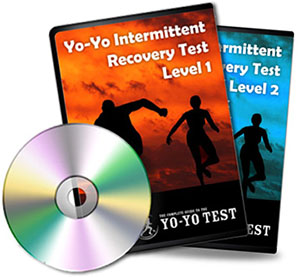The Yo-Yo Endurance Test (continuous) is a variation of the beep test, part of the yo-yo test series developed by the Danish soccer physiologist Jens Bangsbo. There are two versions of this test: Level 1 & 2 (a beginners and advanced level).
The level one test is very similar to the standard beep test, though for speed for most levels is slower. The Level 2 test starts at a higher running speed and has different increments in speed (see Yo-Yo Endurance Test Levels). There is also an intermittent version of the Yo-Yo test, which incorporates a recovery period after each 40m (2x20m) run. The intermittent version of the test is the most popular, and is what most people are referring to when they discuss the yo-yo test.
test purpose: The test evaluates an individual's aerobic endurance fitness.
equipment required: Flat, non-slip surface, marking cones, measuring tape, pre-recorded audio cd or mp3 (buy or use the Team BeepTest software), cd player, recording sheets.
pre-test: Explain the test procedures to the subject. Perform screening of health risks and obtain informed consent. Prepare forms and record basic information such as age, height, body weight, gender, test conditions. Measure and mark out the test area. Perform an appropriate warm-up. See more details of pre-test procedures.

procedure: Use cones to mark out two lines 20 meters apart as per the diagram. The participants start with their foot behind one of the lines, and begin running when instructed. They continue running between the two lines, turning when signaled by the recorded beeps. After each minute or so, the pace gets quicker. If the line is not reached in time the subject must run to the line, turn and try to catch up with the pace within 2 more ‘beeps’. The test is stopped if the subject fails to catch up with the pace within the two ends.
variations: There are two versions of this test: Level 1 & 2. The level one test is similar to the standard beep test. The Level 2 test starts at a higher running speed and has different increments in speed. See Yo-Yo Endurance Test levels. See also about Beep Test modifications.
scoring: The athlete's score is the total distance covered before they were unable to keep up with the recording. The Yo-Yo intermittent test usually takes between 6-20 minutes for level 1 and between 2-10 minutes for level 2. See some Yo Yo Test Results.
target population: This test is suitable for sports teams and school groups, but not for populations in which a maximal exercise test would be contraindicated. It is commonly performed by soccer players.
reliability: Reliability would depend on how strictly the test is run, and the previous practice allowed for the participants.
advantages: Large groups can perform this test all at once for minimal costs.
disadvantages: Practice and motivation levels can influence the score attained, and the scoring of when a person is out of the test can be subjective. As the test is usually conducted outside, the environmental conditions can also affect the results. The test cd must be purchased.
other considerations: This test is a maximal test, which requires a reasonable level of fitness. It is not recommended for recreational athletes or people with health problems, injuries or low fitness levels. You may not have power where you want to conduct this test. If so, you need to ensure that the batteries of the audio player are fully charged.
comments: This test was developed by the Danish soccer physiologist Jens Bangsbo and his colleagues.
references:
- Original description of the test: Fitness Training in Football, a scientific approach - by Jens Bangsbo, publisher August Krogh Institute - Copenhagen University (December 1994).
- Krustrup, P., Mohr, M., Amstrup, T., Rysgaard, T., Johansen, J., Steensberg, A., Redersen, P, K., Bangsbo, J. (2003) The Yo-Yo Intermittent Recovery Test: Physiological Response, Reliability, and Validity. Medicine & Science in Sports & Exercise. 35(4), 697-705. This study found that the Yo-Yo Intermittent Recovery Test "had a high reproducibility and sensitivity, allowing for detailed analysis of the physical capacity of athletes in intermittent sports. Specifically, the Yo-Yo intermittent recovery test was a valid measure of fitness performance in soccer. During the test, the aerobic loading approached maximal values, and the anaerobic energy system was highly taxed. Additionally, the study suggests that fatigue during intense intermittent short-term exercise was unrelated to muscle CP, lactate, pH, and glycogen."
- Krustrup P, Mohr M, Nybo L, Jensen JM, Nielsen JJ, Bangsbo J. (2006) The Yo-Yo IR2 test: physiological response, reliability, and application to elite soccer. Medicine & Science in Sports & Exercise. Sep;38(9):1666-73. This study concluded that the "Yo-Yo IR2 test is reproducible and can be used to evaluate an athlete's ability to perform intense intermittent exercise with a high rate of aerobic and anaerobic energy turnover. Specifically, the Yo-Yo IR2 test was shown to be a sensitive tool to differentiate between intermittent exercise performance of soccer players in different seasonal periods and at different competitive levels and playing positions."
Similar Tests
Related Pages
- Beep Test Software — provides the standard beep test and yoyo tests right on your PC or Laptop, with many additional features.
- Some Yo-Yo Test Results and Yo-Yo test norms
- Buying the yo-yo test
- More Modified Beep Tests
- See a video example of this test being performed.
- The complete guide to the beep test for links to more information.
- The JAM test, another 'beep' type test with variable intensities based on the sport of Rugby.



 Current Events
Current Events